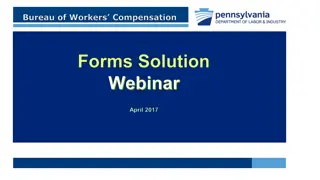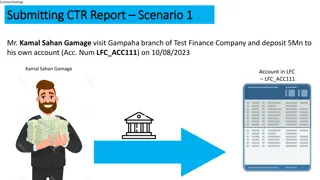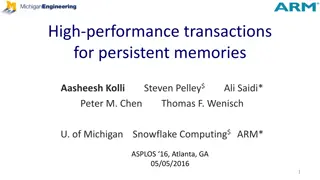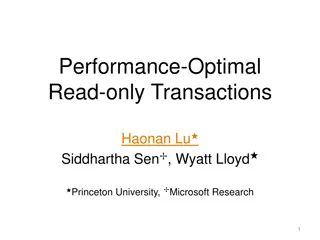
Advanced Transactions and Timestamps in Databases
Learn about timestamps, savepoints, chained transactions, nested transactions, and more in advanced database management with Dr. Nicholas Gibbins. Understand the importance of timestamp ordering, avoiding conflicts, and ensuring serialisability for efficient transaction processing.
Download Presentation

Please find below an Image/Link to download the presentation.
The content on the website is provided AS IS for your information and personal use only. It may not be sold, licensed, or shared on other websites without obtaining consent from the author. If you encounter any issues during the download, it is possible that the publisher has removed the file from their server.
You are allowed to download the files provided on this website for personal or commercial use, subject to the condition that they are used lawfully. All files are the property of their respective owners.
The content on the website is provided AS IS for your information and personal use only. It may not be sold, licensed, or shared on other websites without obtaining consent from the author.
E N D
Presentation Transcript
Timestamps and Advanced Transactions COMP3211 Advanced Databases Dr Nicholas Gibbins nmg@ecs.soton.ac.uk 2020-2021
Overview Timestamps Savepoints Chained transactions Nested transactions Sagas 3 3
Timestamps An alternative to locks deadlock cannot occur Timestamps are unique identifiers for transactions the transaction start time: TS(T) For each resource X, there is: A read timestamp, read-TS(X) A write timestamp, write-TS(X) read-TS(X) and write-TS(X) are set to the timestamp of the most recent corresponding transaction that accessed resource X 5
Timestamp Ordering Transactions are ordered based on their timestamps Schedule is serialisable Equivalent serial schedule has the transactions in order of their timestamps For each resource accessing by conflicting operations, the order in which the resource is accessed must not violate the serialisability order 6
Basic Timestamp Ordering TS(T) is compared with read-TS(X) and write-TS(X) Has this item been read or written before transaction T has had an opportunity to read/write? Ensure that timestamp ordering is not violated If timestamp ordering is violated, transaction is aborted and resubmitted with a new timestamp 7
Basic Timestamp Ordering: write(X) if if read-TS(X) > TS(T) or write-TS(X) > TS(T) then then abort and rollback T and reject operation else else execute write(X) set write-TS(X) to TS(T) 8
Basic Timestamp Ordering X time 9 9
Basic Timestamp Ordering X write-TS(X) time 10 10
Basic Timestamp Ordering X T1 write-TS(X) TS(T1) time 11 11
Basic Timestamp Ordering X T2 T1 write-TS(X) TS(T1) TS(T2) time 12 12
Basic Timestamp Ordering X T2 T1 write(X) write-TS(X) TS(T1) TS(T2) time 13 13
Basic Timestamp Ordering X write-TS(X) < TS(T1) write-TS(X) := TS(T1) T2 T1 write(X) TS(T1) write-TS(X) TS(T2) time 14 14
Basic Timestamp Ordering X write-TS(X) < TS(T1) write-TS(X) := TS(T1) T2 T1 write(X) TS(T1) TS(T2) time write-TS(X) 15 15
Basic Timestamp Ordering X write-TS(X) < TS(T1) write-TS(X) := TS(T1) T2 write(X) T1 write(X) TS(T1) TS(T2) time write-TS(X) 16 16
Basic Timestamp Ordering X write-TS(X) < TS(T1) write-TS(X) := TS(T1) write-TS(X) < TS(T2) write-TS(X) := TS(T2) T2 write(X) T1 write(X) TS(T1) TS(T2) time write-TS(X) 17 17
Basic Timestamp Ordering X write-TS(X) < TS(T1) write-TS(X) := TS(T1) write-TS(X) < TS(T2) write-TS(X) := TS(T2) T2 write(X) T1 write(X) TS(T1) TS(T2) time write-TS(X) 18 18
Basic Timestamp Ordering X T2 T1 write-TS(X) TS(T1) TS(T2) time 19 19
Basic Timestamp Ordering X T2 write(X) T1 write-TS(X) TS(T1) TS(T2) time 20 20
Basic Timestamp Ordering X write-TS(X) < TS(T2) write-TS(X) := TS(T2) T2 write(X) T1 TS(T1) write-TS(X) TS(T2) time 21 21
Basic Timestamp Ordering X write-TS(X) < TS(T2) write-TS(X) := TS(T2) T2 write(X) T1 TS(T1) TS(T2) write-TS(X) time 22 22
Basic Timestamp Ordering X write-TS(X) < TS(T2) write-TS(X) := TS(T2) T2 write(X) T1 write(X) TS(T1) TS(T2) write-TS(X) time 23 23
Basic Timestamp Ordering X write-TS(X) < TS(T2) write-TS(X) := TS(T2) write-TS(X) > TS(T1) T2 write(X) T1 write(X) TS(T1) TS(T2) write-TS(X) time 24 24
Basic Timestamp Ordering X write-TS(X) < TS(T2) write-TS(X) := TS(T2) write-TS(X) > TS(T1) T2 write(X) abort T1 T1 write(X) TS(T1) TS(T2) write-TS(X) time 25 25
Basic Timestamp Ordering: read(X) if if write-TS(X) > TS(T) then then abort and rollback T and reject operation else else execute read(X) set read-TS(X) to max(TS(T), read-TS(X)) 26
Thomass Write Rule Modification of Basic TO that rejects fewer write operations Weakens the checks for write (X) so that obsolete write operations are ignored Does not enforce serialisability 27
Thomass Write Rule if if read-TS(X) > TS(T) then then roll back T and reject operation if if write-TS(X) > TS(T) then then do not execute write (X) continue processing else else execute write(X) set write-TS(X) to TS(T) 28
Flat Transactions Transactions considered so far are flat transactions Basic building block Only one level of control by the application All-or-nothing (commit or abort) The simplest type of transaction! 29
Long Duration Transactions Transactions considered so far are short duration Banking or ticket reservations as example applications Transactions complete in minutes, if not seconds Long-lived transactions present particular challenges More susceptible to failure (and rollback not acceptable) May lock and access many data items (increases chance of deadlock) 30 30
Savepoints Savepoint: an identifiable point in a flat transaction representing a partially consistent state which can be used as an internal restart point for the transaction Used for deadlock handling partially rollback transaction in order to release required locks Savepoints may be persistent Following a system crash, restart active transactions from their most recent savepoints 32
Savepoints START T1 operation 1 operation 2 operation 3 SAVEPOINT 1 operation 4 operation 5 operation 6 SAVEPOINT 2 operation 7 operation 8 operation 9 ROLLBACK to 1 33 33
Savepoints START T1 operation 1 operation 2 operation 3 work covered by savepoint 1 SAVEPOINT 1 operation 4 operation 5 operation 6 SAVEPOINT 2 operation 7 operation 8 operation 9 ROLLBACK to 1 34 34
Savepoints START T1 operation 1 operation 2 operation 3 work covered by savepoint 1 SAVEPOINT 1 operation 4 operation 5 operation 6 operation 4 operation 5 operation 6 SAVEPOINT 3 SAVEPOINT 2 operation 7 operation 8 operation 9 operation 7 operation 8 operation 9 SAVEPOINT 4 ROLLBACK to 1 35 35
Chained Transactions Transaction broken into subtransactions which are executed serially On chaining to the next subtransaction: commit results keep (some) locks Cannot rollback to previous subtransaction START T1 operation 1 operation 2 operation 3 CHAIN operation 4 operation 5 operation 6 CHAIN 37 37
Savepoints versus Chained Transactions Both allow substructure to be imposed on a long-running application program Database context is preserved Cursors are kept Commit vs Savepoint Chained - rollback only to previous savepoint Savepoints - can rollback to arbitrary savepoint Locks Chained frees unwanted locks 38 38
Savepoints versus Chained Transactions Work lost Savepoints more flexible than flat transactions, as long as the system does not crash Restart Chained transactions can restart from most recent commit, as long as no processing context hidden in local programming variables Both organise work into a sequence of actions 39 39
Nested Transactions Transaction forms a hierarchy of subtransactions (partial order on set of subtransactions) Subtransactions may abort without aborting their parent transaction May restart subtransaction Three rules for nested transactions: Commit Rule Rollback Rule Visibility Rule 41
Nested Transactions START T invoke T/1 invoke T/2 invoke T/3 COMMIT 42
Nested Transactions START T START T/1 invoke T/1/1 invoke T/1 invoke T/1/2 COMMIT invoke T/2 invoke T/3 COMMIT 43
Nested Transactions START T START T/1 START T/1/1 invoke T/1/1 COMMIT invoke T/1 invoke T/1/2 COMMIT invoke T/2 invoke T/3 COMMIT 44
Nested Transactions START T START T/1 START T/1/1 invoke T/1/1 COMMIT invoke T/1 invoke T/1/2 START T/1/2 COMMIT COMMIT invoke T/2 invoke T/3 COMMIT 45
Nested Transactions START T START T/1 START T/1/1 invoke T/1/1 COMMIT invoke T/1 invoke T/1/2 START T/1/2 COMMIT START T/2 COMMIT invoke T/2 COMMIT invoke T/3 COMMIT 46
Nested Transactions START T START T/1 START T/1/1 invoke T/1/1 COMMIT invoke T/1 invoke T/1/2 START T/1/2 COMMIT START T/2 COMMIT invoke T/2 COMMIT START T/3 invoke T/3 invoke T/3/1 COMMIT COMMIT 47
Nested Transactions START T START T/1 START T/1/1 invoke T/1/1 COMMIT invoke T/1 invoke T/1/2 START T/1/2 COMMIT START T/2 COMMIT invoke T/2 COMMIT START T/3 invoke T/3 START T/3/1 invoke T/3/1 COMMIT COMMIT COMMIT 48
Commit Rule The commit of a subtransaction makes the results accessible only to the parent The final commit happens only when all ancestors finally commit 49 49
Rollback Rule If any [sub]transaction rolls back, all of its subtransactions roll back 50 50






















